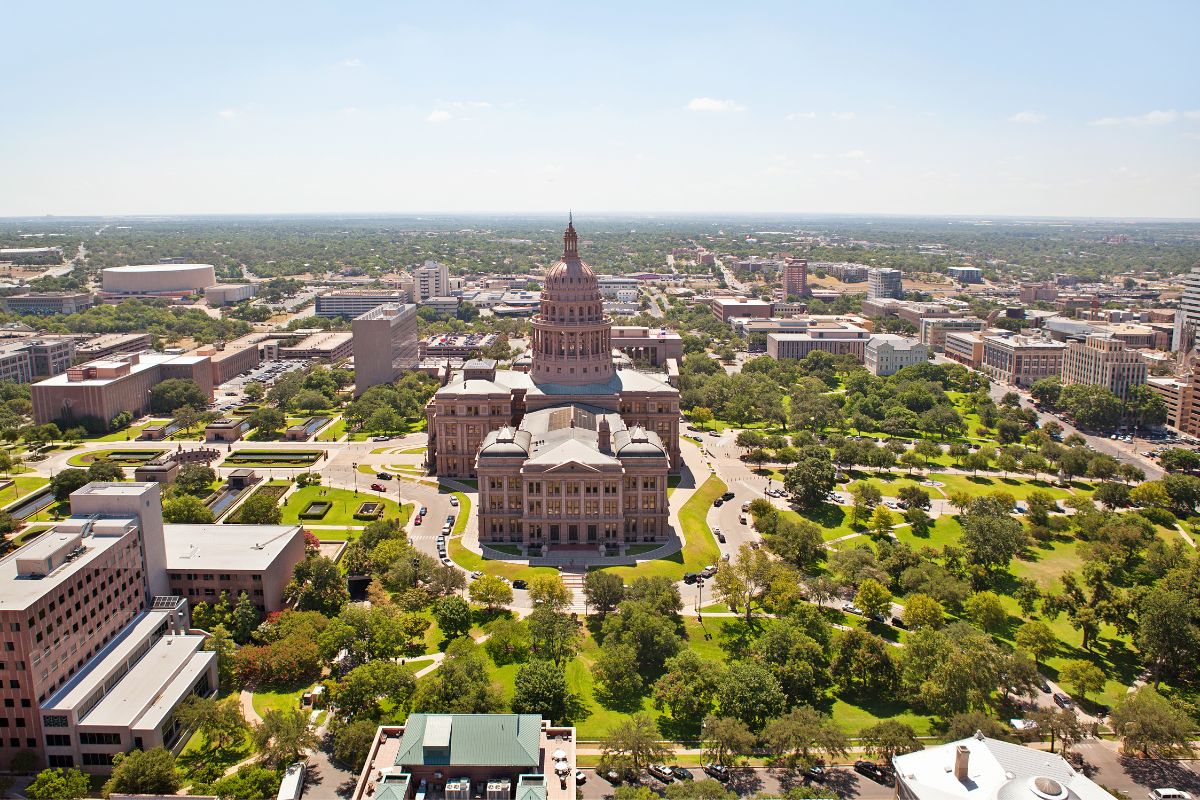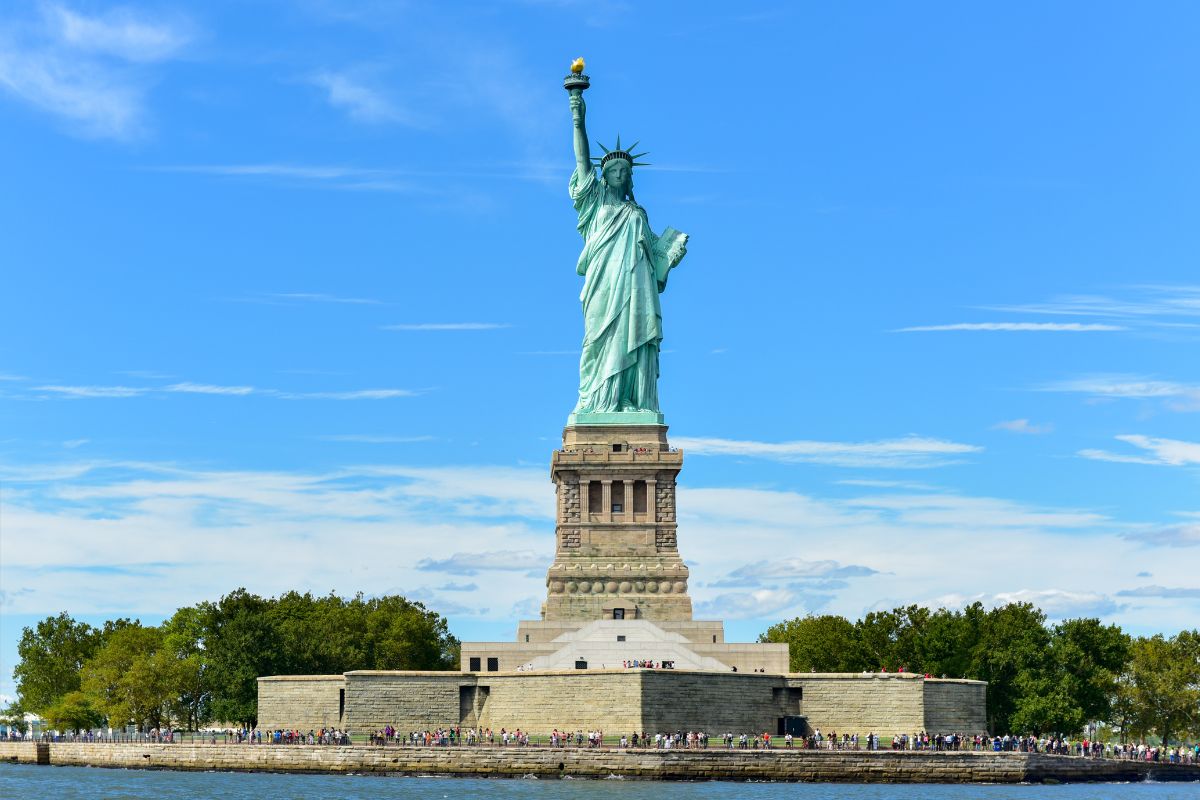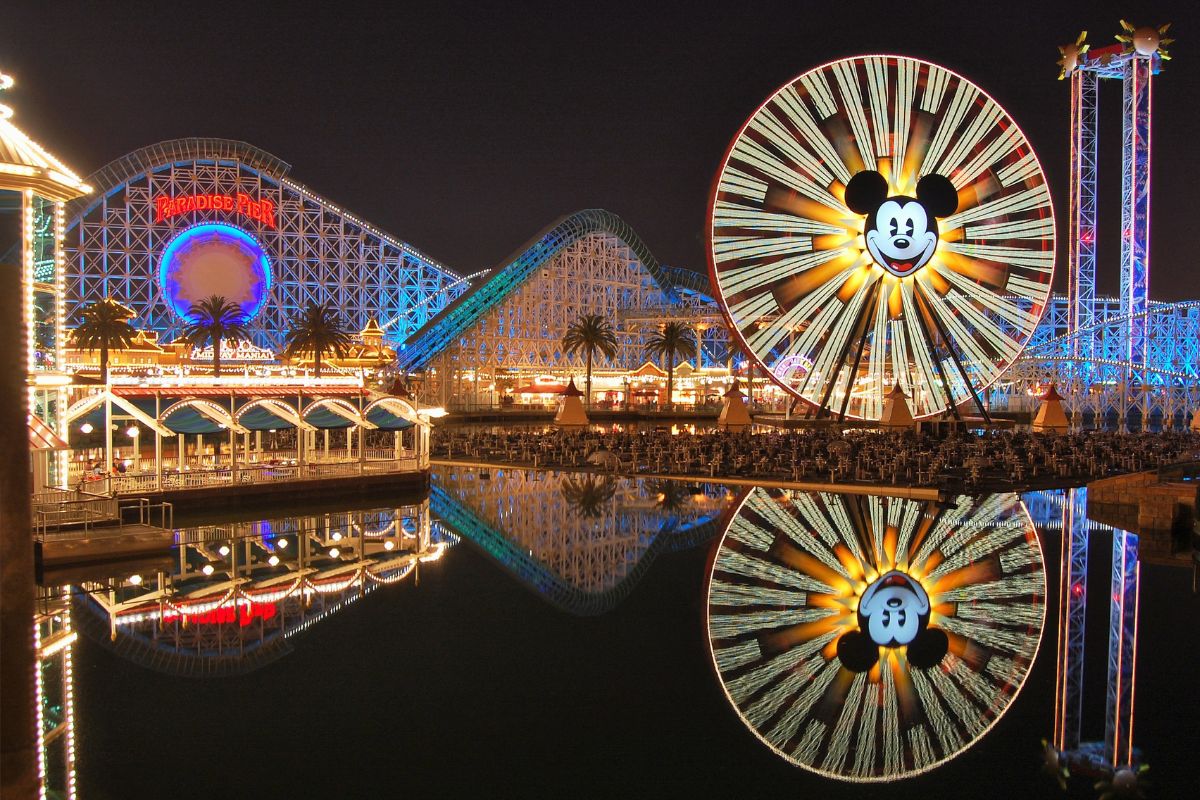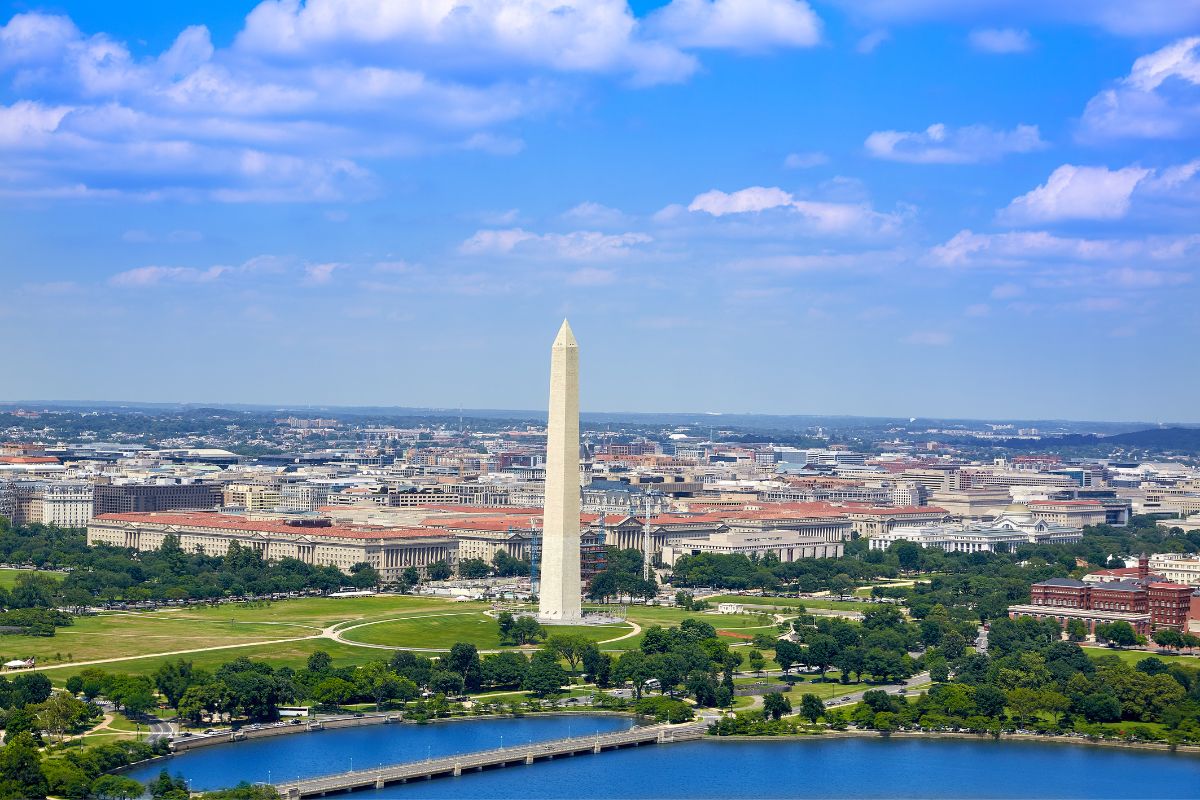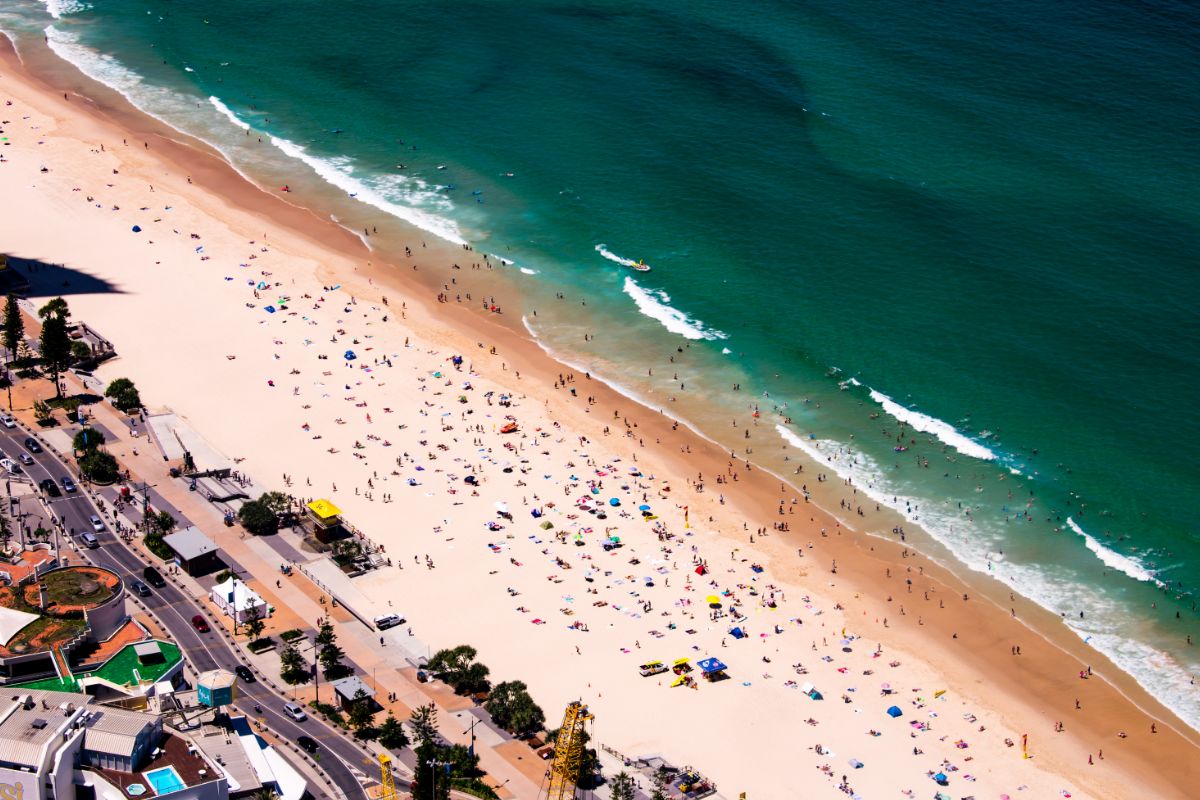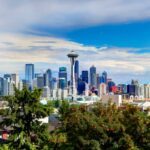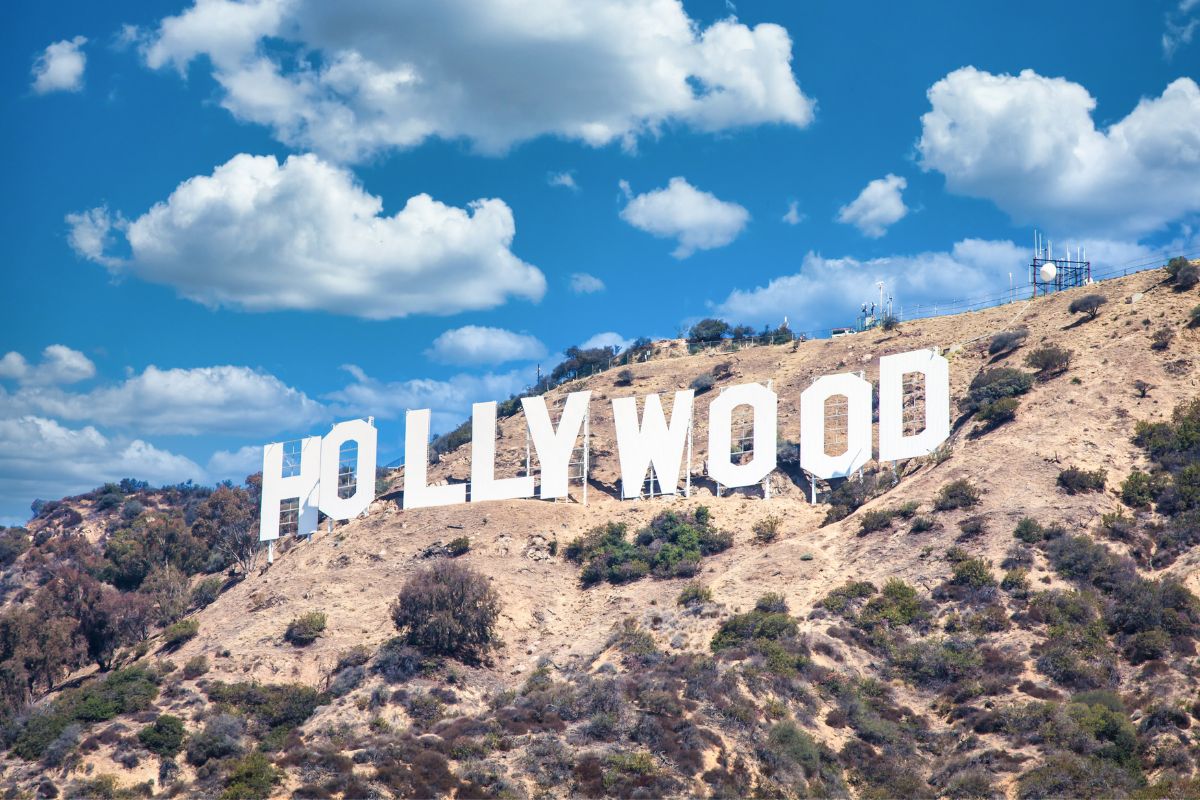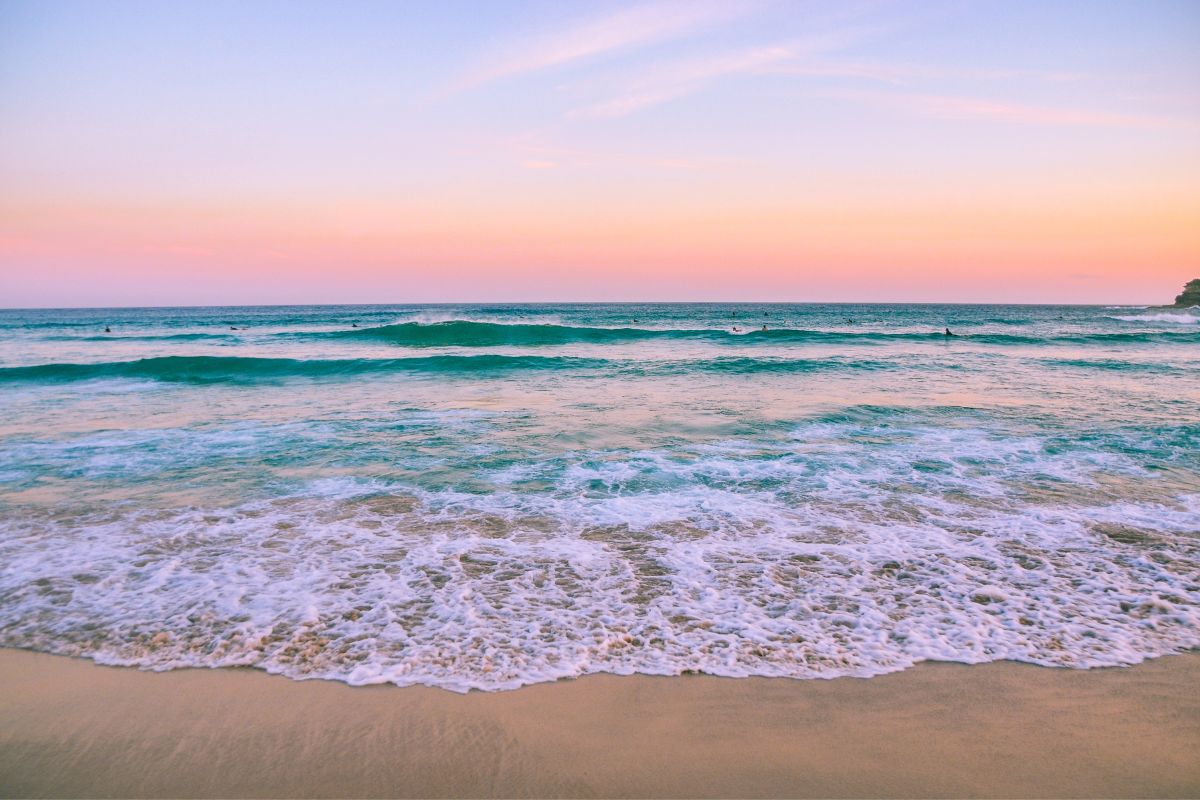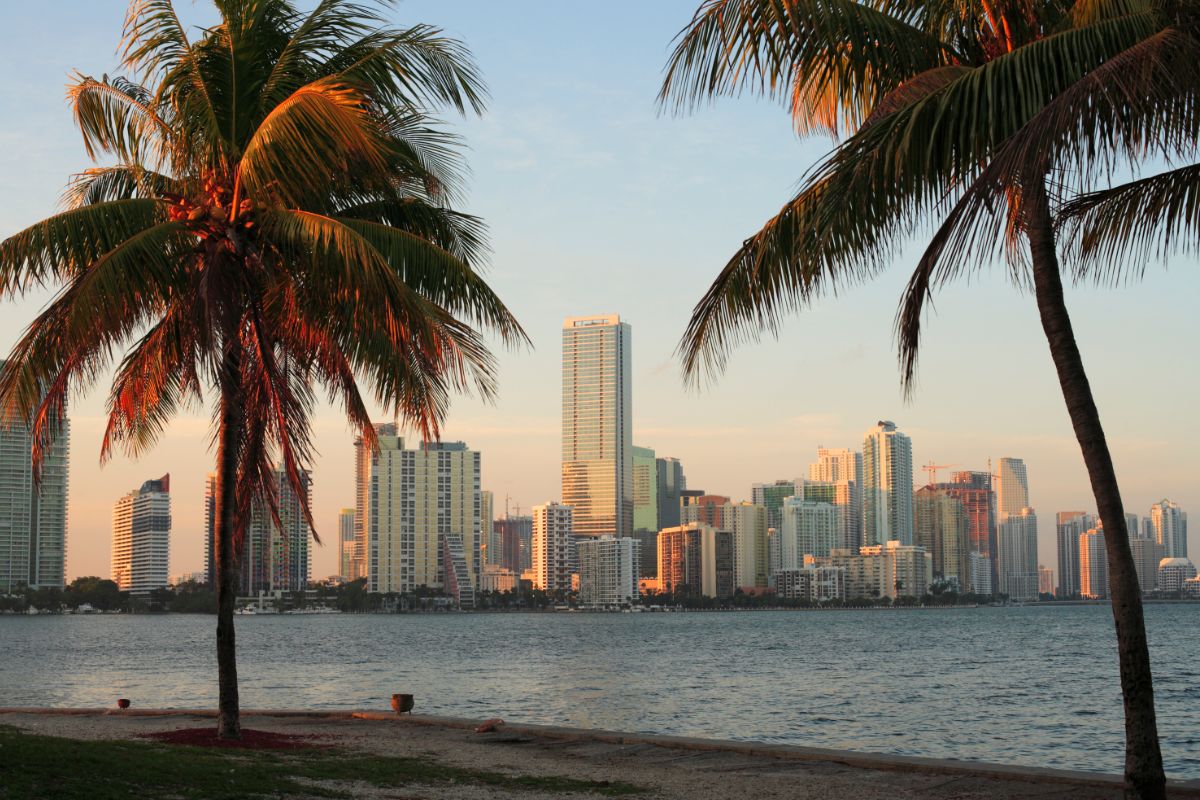The United States is home to some of the world’s most breathtaking landscapes and iconic landmarks. It’s the reason why tourists travel from all over the globe to visit some of the country’s top attractions.
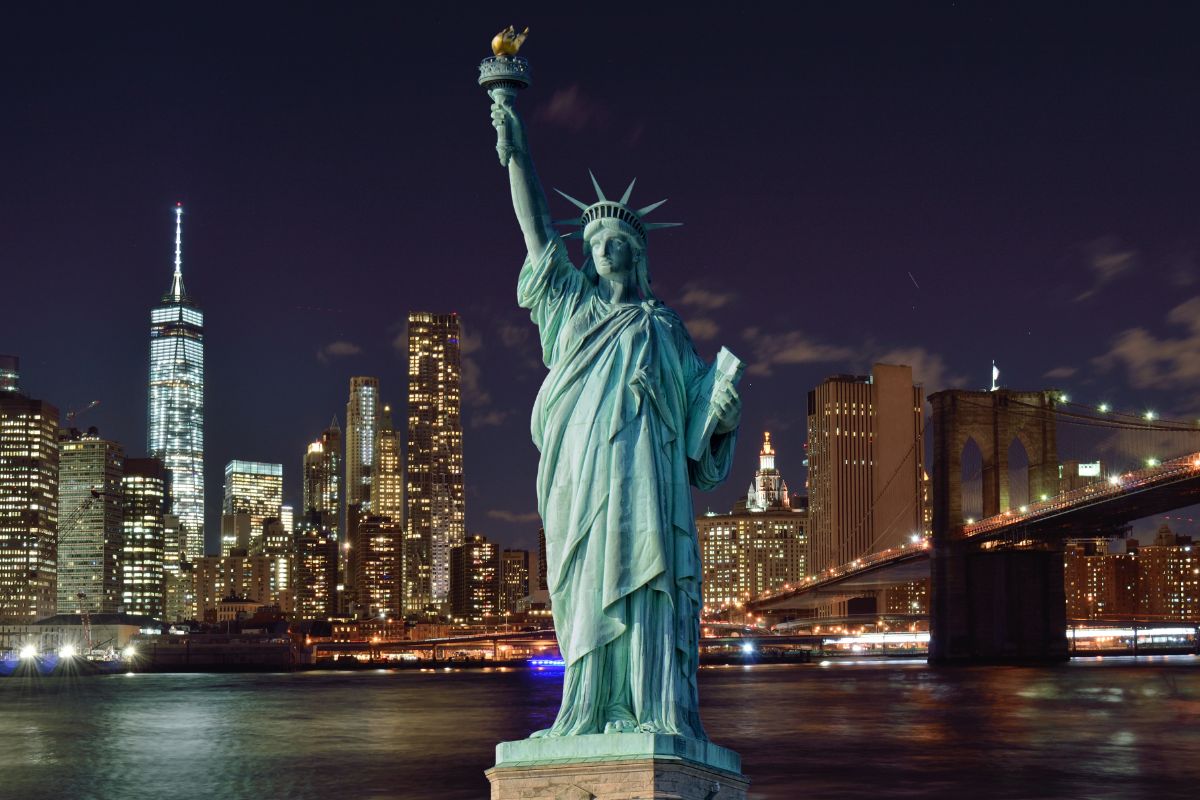
From rich history to exciting nightlife, the US truly does have something for everyone.
It’s only right that we appreciate the incredible places to see with this list of some of the best and most famous attractions in the US. From Disney World to the Washington Monument, here are a few of the amazing attractions that America has to offer.
1. The Washington Monument – Washington D.C.
The Washington Monument, which stands just over 555 feet tall and was constructed to honor George Washington, the commander-in-chief of the Continental Army and the country’s first president, briefly held the record for the tallest structure in the world.
The monument honoring the nation’s first president continues to hold the record for being the tallest stone obelisk in the world.
The Washington Monument, which is maintained by the National Park Service, is situated in the middle of the National Mall, between the Lincoln Memorial and the U.S. Capitol.
The Washington Monument has boosted expectations for visitors with a new state-of-the-art elevator that can efficiently take hundreds of visitors up to the observation deck in just a matter of minutes.
The U.S. Capitol, the White House, Arlington National Cemetery, and the Washington National Cathedral can all be seen from the observation deck, which extends approximately 25 miles into the horizon in all directions.
2. The Statue of Liberty – New York City, New York
The Statue of Liberty is one of the most well-known sites in the United States and a timeless image of liberty and freedom. She is situated on Liberty Island in New York Harbor, just off Lower Manhattan in New York City.
Édouard de Laboulaye, a French political philosopher, suggested designing Lady Liberty Enlightening the World as a gift to the United States in 1865.
This celebration of the Declaration of Independence’s 100th anniversary is a collaborative effort between the United States and France.
The 22-story statue, created by the French sculptor Frédéric-Auguste Bartholdi, was finally erected in 1886 on what is now Liberty Island.
The statue, which is 305 feet tall including the pedestal, shows a woman holding a torch in her raised right hand and a tablet with the date the Declaration of Independence was adopted in her left.
A spiral staircase leads to a viewing platform in the figure’s crown, and an elevator takes guests to the observation deck on the pedestal. From there, an incredible view of New York City can be seen.
3. Mount Rushmore – Keystone, South Dakota
Four enormous sculptures of George Washington, Thomas Jefferson, Abraham Lincoln, and Theodore Roosevelt are carved into the southeast face of Mount Rushmore in South Dakota’s Black Hills National Forest.
Doane Robinson, the state historian of South Dakota, first proposed the idea of erecting a massive sculpture in the Black Hills in 1923.
Robinson had envisioned portraying notable figures from the American Old West and Native American history on a needle-like rock structure at Custer State Park.
One of the most recognizable pictures of America, Mount Rushmore National Memorial is also known as the “Shrine of Democracy.”
As the setting for a pivotal chase sequence in Alfred Hitchcock’s movie “North by Northwest” in 1959, it attracted even more recognition and a surge of tourists that wanted to see this historic location.
One of the greatest works of art in the world as well as one of the most visited tourist destinations in the United States, the 60-foot-high faces were carved out of the granite rock face between 1927 and 1941.
4. The Strip – Las Vegas, Nevada
The world’s tallest observation wheel, dancing fountains, erupting volcanoes, singing gondoliers, roller coasters, and mash-up replicas of the most famous locations in the world can all be found on the famous Las Vegas Strip.
The Las Vegas Strip is one of the most well-known avenues on Earth, drawing over 43 million tourists a year to the mega-resorts that line both sides of the road despite its 4.2-mile length from Sahara Avenue to Russell Road.
The Strip is home to renowned hotels and casinos, as well as the frequently photographed “Welcome to Fabulous Las Vegas, Nevada” sign.
The pyramid-shaped Luxor, the intricately themed Treasure Island, the man-made cove, the old-world MGM Grand, the opulent Caesars Palace, Shark Reef at the Mandalay Bay, and Bellagio, where the nightly lit fountain show draws large crowds of visitors, are just a few of the highlights.
The Strip is less busy during the day, but it is more kid-friendly. Visitors of various ages visit the numerous stores in the casino galleries and enjoy the cuisine at upscale eateries and fast-food joints.
It’s true that neither day nor night will ever be boring on The Strip.
5. Central Park – New York City, New York
Central Park is a creation of man and arguably one of the most well-known parks in the world. In addition to being the country’s first built-in public park, it also receives more than 25 million visitors annually, making it one of the busiest.
The grounds of this bustling Manhattan landmark provide a safe refuge not only for pedestrians, musicians, and athletes but also for countless migratory birds each year.
A tranquil day can be spent wandering the grounds, taking in the approximately 50 fountains, statues, and monuments or the 36 bridges and arches.
The more active won’t have any trouble finding a place to skate, pedal, row, or run to their heart’s content because recreational facilities are plentiful at the park.
Even though Central Park has 21 designated playgrounds, during the summer months it resembles one enormous jungle gym.
6. The Grand Canyon – Arizona
Northern Arizona is home to the Grand Canyon, a mile-deep gorge. According to scientists, the Colorado River started carving a passage through rock layers about 5 to 6 million years ago, which is when the canyon may have started to form.
The Grand Canyon was first made a forest reserve by President Benjamin Harrison in 1893, and it was formally designated a United States National Park in 1919.
One of the largest valleys in the world, the canyon is over 270 miles long, and up to 18 miles wide. Some of the oldest exposed rock on Earth can be found there, as well as a cross-section of the Earth’s crust dating back over two billion years in the mile-high walls.
Geologists now have the chance to examine how evolution has changed over time thanks to these rock strata.
Today, the Grand Canyon receives about five million visitors annually from all over the world. The Grand Canyon Skywalk, a cantilevered walkway with a glass floor that hangs over a western portion of the canyon, is one recent addition.
Here, visitors may look down and get a better sense of how big it is.
7. Niagara Falls – New York
One of North America’s most well-known sights is Niagara Falls, a cascade on the Niagara River in the northeast. The falls are located on the border of New York, United States, and Ontario, Canada.
For many years, honeymooners and performers of dangerous stunts like tightrope walking and barrel riding over the falls were drawn to the area. But more and more, the site’s beauty and singularity as physical phenomena are what draw people in.
At a speed of 20 to 30 mph, the enormous Niagara River thunders toward a 188-foot cascade. The rapidity of the river’s descent produces a foggy fog and an audible roar that can be heard for miles.
Crowds gather at the rails from the top to feel the mist on their faces, while boats, platforms, and observation decks provide support for tourists wearing vibrant ponchos as you descend along the water’s course.
8. Disney World – Orlando, Florida
Known as the most magical place on Earth, Disney World in Orlando, Florida is a highly popular attraction amongst tourists, with some spending their entire trip at the resort.
Disney World features four theme parks, two waterparks, 24 hotels, five golf courses, two spas, a sports complex, and its very own shopping mall spanning 40 square miles of land.
Magic Kingdom Park, which features some of Disney’s most recognizable attractions, enchanted encounters with beloved Disney characters, and unique seasonal events, is the jewel of Disney World.
EPCOT, Animal Kingdom, and Hollywood Studios are also at the resort, ready to be explored.
Typhoon Lagoon and Blizzard Beach, two enormous water parks, are the ideal complement to the theme parks. These parks have comparable amenities, yet they have very diverse themes and each has unique particular features.
9. The Liberty Bell – Philadelphia, Pennsylvania
The Liberty Bell is one of the most popular historical landmarks in the country and is considered to be the ultimate symbol of American freedom.
It is located inside the Liberty Bell Center, which is situated on 6th Street between Market and Chestnut Streets and takes up nearly a whole city block.
It is said that on July 8, 1776, the Liberty Bell rang out from the Independence Hall tower, calling the people of Philadelphia to hear Colonel John Nixon read the Declaration of Independence aloud for the first time in public.
You may find out more about the bell’s lengthy history today, as well as the controversy surrounding how it was cracked.
Exhibits regarding the history of the Liberty Bell may be found inside the Liberty Bell Center. These include the Liberty Bell itself, as well as authentic relics, pictures, x-rays of the crack, and excellent videos.
10. Kennedy Space Center – Merritt Island, Florida
Since the late 1960s, all manned space flights of the federal government have been conducted from NASA’s Kennedy Space Center in Florida.
It bears the name of President John F. Kennedy, who made the legendary claim that the United States would send an astronaut to the moon and successfully return him or her to Earth by the end of the decade in 1961.
In fact, Apollo 11 launched from there, which ultimately put Neil Armstrong on the moon.
Over the past few years, the Kennedy Space Center Visitor Complex has averaged 1.5 million visitors annually. A variety of displays, movies, and Kennedy Space Center tours can be found at the Visitor Complex.
It is the only location in the world where you can see a real Saturn V moon rocket up close, touch a moon rock, meet a retired NASA astronaut, tour a NASA spaceflight facility, and see the real space shuttle Atlantis.
11. Yosemite National Park – California
Yosemite Valley, one of the natural wonders of the world, is about eight miles long from east to west and has granite cliffs that are more than twice the height of the Empire State Building.
Few other areas reflect the geological forces that have sculpted our world in such remarkable ways, having been carved by glacier dynamics, weathering, and erosion over 30 million years.
All of the significant landmarks in the valley are passed via a network of circular, one-way roads. The aptly titled Bridalveil Fall, 620 feet of delicate white water cascading down a granite face behind Cathedral Rocks, is the first of the many breathtaking vistas.
Soon, Southside Drive reaches the Merced River, a slow-moving body of water where visitors can go swimming, tubing, rafting, and fishing during the sweltering summers in the valley.
The primary visitor center for the park is located in Yosemite Village, which is where the route eventually ends.
The village offers the Yosemite Museum of Native American culture, the Ansel Adams Gallery of photographic art, and the Yosemite Wilderness Center, where hikers can purchase wilderness permits, bear canisters, and other backcountry necessities.
12. Empire State Building – New York City, New York
In Midtown Manhattan, at Fifth Avenue and 34th Street, is where you’ll find the Empire State Building. The 102-story, steel-framed skyscraper was built in New York City in 1931 and held the record for the highest structure in the world until 1971.
Despite this, it continues to be one of the country’s most recognizable and well-known structures.
The vast majority of people that visit the Empire State Building mainly want to go to the renowned outdoor observation deck and enjoy the views of the city. But there’s more to do there than just take in the scenery.
There are several displays at the Empire State Building where you can find out information about a variety of topics related to the structure.
This provides details on how the Empire State Building was made, as well as its architecture, history, and cultural references.
You can eat at the Empire State Building as well, with a variety of options to choose from, including fast-casual self-service and table service.
13. The Freedom Trail – Boston, Massachusetts
The Freedom Trail leads visitors through Boston on a tour of sixteen locations significant to the American Revolutionary War against British control in the 18th century.
This city’s reputation as “the birthplace of the American Revolution” is largely due to the numerous historical occurrences that took place there and helped spark the War of Independence.
The Freedom Trail typically begins in Boston Common, where British troops camped during the 1775 Boston Occupation.
It then passes by places like the Old State House, where the Declaration of Independence was signed, Faneuil Hall, the scene of numerous pre-war demonstrations, the location of the Boston Tea Party, Old South Meeting House, and the scene of the 1770 Boston Massacre.
Visitors can follow the 2.5-mile Freedom Trail on their own by using the red pavement marks scattered across the city, or they can choose from a variety of guided excursions.
14. The Chicago River – Chicago, Illinois
The 156-mile-long Chicago River flows through Chicago, Illinois, right through the heart of the Chicago Loop. As the link between the Great Lakes and the Mississippi Valley waterways, it is credited with making Chicago a significant destination.
In addition, this river is the only one in the world that has been reversed through civil engineering.
The award-winning, pedestrian-friendly Chicago Riverwalk, which runs 1.25 miles from Lake Michigan to Lake Street, is situated on the south bank of the Chicago River.
Quiet coves, cafes, bars, public art, landmarks, museums, and a plethora of water excursion options can be found along the way.
Visitors can learn everything about Chicago’s extensive history on one of the many free walking tours that are offered along the Riverwalk. The city’s attractions as well as some of the state’s best architecture are highlighted throughout these tours.
15. The Hollywood Sign – Los Angeles, California
A famous landmark and cultural icon in the United States, the Hollywood Sign stands to watch over Hollywood, Los Angeles, California.
It is located atop Mount Lee, in the Beachwood Canyon region of the Santa Monica Mountains, and was first erected as a real estate ad until the people of LA insisted it became a permanent fixture.
Access is limited, and the area is closely watched because of vandalism to the sign and the risks of coming too close to it. However, you can visit the Griffith Observatory to have a better view and get a little closer to the sign.
Visitors can also drive up to the Beachwood Canyon area to get even closer.
The sign, one of California’s and America’s most well-known monuments, is frequently depicted in popular culture, especially in setting shots for motion pictures and television shows set in or near Hollywood.
It is instantly recognizable and continues to be a popular site for tourists.
16. San Antonio’s River Walk – San Antonio, Texas
The biggest urban ecosystem in the country and a jewel of San Antonio is the River Walk, also known as Paseo del Rio.
It offers a calm and enjoyable way to explore the city because it is tucked discreetly below street level and just a few feet from the Alamo.
The River Walk, which runs alongside the San Antonio River in the center of the city, is surrounded by eateries and outdoor dining spaces offering anything from fast food to gourmet dining.
Large oak trees drape over the river and path, offering shade, while small boats drift along the river and under picturesque arching bridges.
A variety of entertainment is available on the River Walk, including seasonal events and live music.
As you go further south along the Mission Reach, you may immerse yourself in history at the San Antonio Missions National Historical Park, a UNESCO World Heritage Site.
17. The White House – Washington D.C.
The White House has served as a representation of the Presidency, the US government, and the American people for the past 200 years.
President George Washington’s signature on a congressional act in December 1790 marked the beginning of both its history and that of the capital of the country.
In October 1792, the first cornerstone was set, signaling the start of construction. President John Adams and his wife, Abigail, didn’t move into the White House until 1800 when it was almost finished.
Since then, every President has added his own modifications. Additionally, it is the only private residence of a head of state that is unreservedly accessible to the general public.
Requests for public tours must go through your representative in Congress and be made up to three months in advance.
The State Dining Room, the China Room, and a view of the White House Rose Garden are among the public spaces in the East Wing of the White House that are included in tours for the general public.
Secret Service agents are posted in each room and are available to respond to inquiries regarding the background and design of each space.
18. French Quarter – New Orleans, Louisiana
One of the oldest districts in New Orleans is the French Quarter. The neighborhood, which was founded in 1718, served as the town’s heart and a key trade hub.
Even when there are no events happening, there are always lots of things to do in the city. Regular events like Mardi Gras in February and the New Orleans Jazz Festival in April bring sizable audiences.
The French Quarter is an excellent area to have a bite to eat and a drink to sip because it has fantastic southern cuisine.
On the cultural front, you can visit the St. Louis Cathedral, stroll around Jackson Square to observe the painters and artisans at work, and take a tour of Mardi Gras World, the facility where the large parade floats are constructed.
19. Kīlauea – Hawaii
Hawaii’s whole archipelago owes its existence to a “hot spot.” Beginning in the mantle, this magma tube has melted a passageway to the surface.
A sequence of volcanoes is formed when this “hot spot” under the Pacific Ocean penetrates the marine crust. Kīlauea is the youngest volcano in the group and is located above sea level.
When compared to the towering, abruptly sloping peaks of stratovolcanoes, Kīlauea is a very low, flat shield volcano. It is one of the planet’s most active volcanoes, making it a priceless asset for volcanologists.
Since 1952, there have been thirty-three eruptions, except the latest eruption, which began on January 3, 1983, and is still happening today.
The volcano can be found in the Hawaii Volcanoes National Park. At the park, ranger talks and guided tours can be scheduled from the Kīlauea Visitors Center, where they offer maps so you can learn about the hikes in the park and get the latest eruption updates.
20. Golden Gate Bridge – San Francisco, California
An iconic structure, the Golden Gate Bridge links Marin County, California, with the city of San Francisco. The Golden Gate, a confined strait where San Francisco Bay opens up to the Pacific Ocean, is almost two miles long.
The Golden Gate Bridge is said to be a wonder of contemporary engineering. Its 746-foot towers made it the tallest bridge of any kind until 1993, and its 4,200-foot main span between the two towers was the longest for a suspension bridge until 1981.
The American Society of Civil Engineers designated this structure, which is thought to be the most photographed bridge in the world, as one of the seven American engineering wonders in 1994.
After the Golden Gate Bridge brought the populations of San Francisco and Marin counties closer together, the historic US Route 101, which stretches from Los Angeles north to San Francisco and beyond, became one of the busiest sections and a must-see structure.
21. Pike Place Market – Seattle, Washington
The Pike Place Market, one of the oldest and biggest continually operating public marketplaces in the United States, was established in 1907 and is supported by hundreds of farmers, artisans, small businesses, and food producers.
For more than a century, the Market has served as a symbol of Seattle. It covers nine historic acres in the heart of downtown and is sometimes referred to as “the soul of Seattle.” Here, locals and visitors alike shop, visit, eat, and explore.
Pike Place had modest beginnings and the residents of Seattle did much to support it and help it develop, which is a monument to the city’s passionate citizens.
It’s great variety of shops, events, and services, which continue to lure tourists every day, serve as its foundation.
22. The Gateway Arch – St. Louis, Missouri
The Gateway Arch National Park extends from the Old Courthouse to the steps overlooking the Mississippi River and was established by the National Park Service in 1935 to honor Thomas Jefferson’s idea of a transcontinental United States.
Construction on the stainless steel arch designed by architect Eero Saarinen began in 1963 after the Memorial’s shape was decided in a 1948 national design competition.
The Gateway Arch, finished in 1965, is a defining example of mid-century modern architecture and a representation of the nation’s identity.
The brilliant archway honors the Louisiana Purchase and the opening of the West to settlers that followed the nearby-departing Lewis and Clark Expedition. The arch’s sturdy, graceful shape symbolizes a gateway to the country’s west.
Visitors can take a four-minute tram ride to the viewing platform at the top of the arch and check out the attractions of the Museum of Westward Expansion, which includes exhibits on daily life in the 1800s and details on how the arch was built.
23. South Beach – Miami, Florida
Three separate districts make up Miami Beach, a narrow barrier island in the Atlantic Ocean that is nine miles long.
The most famous of the three is South Beach, which is known for its sandy beaches, swaying palm trees, and pastel-colored Art Deco structures that have come to symbolize this legendary location and make it so indisputably picturesque.
The majority of tourists go over to Lincoln Road. Brand-name shops and independent boutiques, a variety of restaurants, live street entertainment, and excellent people-watching can all be found along the mile-long pedestrian strip.
Similar attractions can be found a few blocks south on beautiful Española Way, another pedestrian-only street with Mediterranean Revival architecture reflecting sleepy French and Spanish villages.
Of course, the neighborhood’s main appeal is the beach. The best of both land and sea can be enjoyed in beachfront open spaces like Lummus Park and South Pointe Park, giving visitors the chance to take in this classic Miami Beach scene.
Final Thoughts
As you can see, the US has some absolutely awe-inspiring attractions that are worthy of anyone’s bucket list.
Both educational and exciting, America is incredibly diverse when it comes to places to see and things to do. No matter where you go, you’ll never be disappointed!
- The 10 Most Dog Friendly Hotels in Glasgow: A Comprehensive Guide for Pet Parents - September 29, 2023
- The 8 Best Dog Friendly Hotels In Liverpool For You And Your Dog - September 25, 2023
- The 8 Best Dog Friendly Hotels In Weymouth For Your Coastal Trip - September 23, 2023

